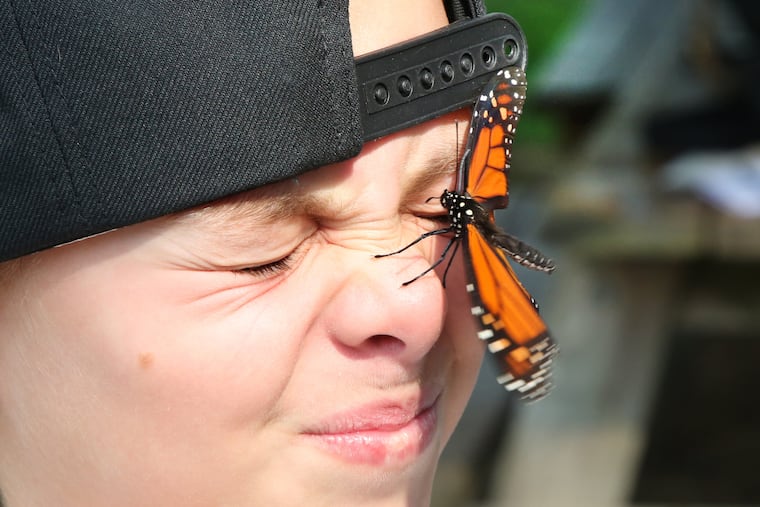In Cape May, it’s time to party with monarchs and feel the wonder. But can we also help save them?
Monarch butterflies' epic journey from Cape May to Mexico is one of nature's great migrations. Now conservationists say they need our help to make it continue.

On a recent visit to Cape May, even before Ruby Naumann felt a monarch butterfly’s thread-like legs dance across her nose, the South Philly kid got to discover all sorts of magical things.
Like how monarchs taste with their feet, and that the tiny scales which give them their brilliant orange hue feel like pixie dust on your fingertips.
She learned about monarchs’ epic journey — their legendary fall migration that spans nearly 3,000 miles from Canada down to Cape May and over to Mexico’s Central Highlands in Michoacan. Lighter than a grain of wheat, these delicate creatures brave headwinds, cold fronts, and all manner of storms in their sojourn south. Quite a few won’t survive. Many that do will arrive in time for Mexico’s El Dia de los Muertos — the Day of the Dead — when, according to ancient lore, the monarchs carry the souls of the dearly departed back to Earth.
The monarchs then roost in mountain fir trees until spring, when they begin the trek back north.
“I think they’re amazing!” said Ruby, 9.
Indeed they are. And this weekend, they will be celebrated.
New Jersey Audubon will hold its Monarch Festival on Sept. 25 at the Nature Center of Cape May.
Among the festivities, the staff of the Monarch Monitoring Project will be on hand to give butterfly tagging demonstrations, like the one in which Ruby took part.
An initiative of New Jersey Audubon’s Cape May Bird Observatory, the Monarch Monitoring Project has been tagging monarchs that move through Cape May from the north in September and October since 1990. So far, about 100,000 monarchs have been tagged with stickers on their wings by the group, including nearly 100 that have turned up in Mexico.
Like the other groups and private individuals that take part in the tagging effort along the migration route, MMP’s researchers share their information with Monarch Watch, a project of the University of Kansas. The tagging has helped scientists learn much about this butterfly’s unique migration, including the timing, course, and pace, where they come from, and how many of them make it to Mexico.
In addition to teaching us more about these fascinating creatures, the information may help them as well. Monarchs are in trouble.
Earlier this summer, the International Union for the Conservation of Nature put monarchs on its Red List of endangered species, said Adehl Schwaderer, who oversees the MMP as the Cape May Bird Observatory’s program coordinator. The butterflies were already classified as threatened by the U.S. federal government.
The eastern monarch population, which includes Cape May’s annual visitors, declined by 84% from 1996 to 2014, according to the IUCN, while western monarchs’ numbers have neared extinction, falling from 10 million to about 1,900 since the 1980s.
“The monarch is the canary in the coal mine,” said Louise Zemaitis, MMP field coordinator who has been with the project almost from its start. “As its numbers decline, that signals to us that something is wrong.”
What’s bad for the monarchs isn’t good for humans either, she said. Climate change, loss of habitat, overuse of pesticides, deforestation — all those factors are to blame for the decline in monarchs, which like other insects are important in their role as pollinators.
So along with collecting data, the staff of the MMP perform another significant role: education.
The project’s two field naturalists do plenty of that in the tagging demonstrations held at the nature center Fridays, Saturdays, and Sundays in September through October.
Jack McDonough, one of the naturalists, fell in love with insects and other creatures of the natural world when he was a boy, and the passion never left him. He pays special attention to the younger members of his audience.
“I’m a science guy. I love data and all those things, but there’s nothing quite like changing someone’s life,” McDonough said.
There’s no shortage of wonder when it comes to monarchs.
A lot of our knowledge about monarchs is relatively recent. Science hadn’t pinpointed where monarchs wintered until the 1970s, although the butterflies’ Mexican neighbors always knew. The first documented monarch to make it from Cape May to Mexico was in 1998, said Zemaitis.
The monarchs that travel south can cover a lot of ground quickly. One butterfly tagged in Cape May was found about 130 miles away in Virginia just 24 hours later, she said.
Monarchs that manage to survive the long journey overwinter in Mexican mountain fir trees in a semi-dormant state until, months later, spring calls them back north.
But no individual monarchs will complete that whole return leg of the migration. Instead, it will take about four generations of monarchs to accomplish. For each segment of the migration north, the butterflies, with mating life spans of up to about six weeks, will reproduce, die, and their offspring will take up the next part of the journey north, which typically ends in Canada.
Essential to the creatures is nutrition, and for these butterflies, that especially means milkweed. It’s crucial to their life cycle, as a place to lay their eggs, as food for the growing caterpillars, and ultimately protection.
Also important is the nectar of plants like goldenrod to fuel the flight of adult butterflies. Pesticides and habitat loss has cut down the availability of all-important native plants like milkweed.
Ruby and about a dozen others who visited the Cape May monarch project were told about the importance of planting butterfly gardens and were sent home with native plant seeds.
“The good news is everyone can help to make a difference,” Zemaitis told them. “If you go away with anything today, I hope it’s, ‘I can help.’”